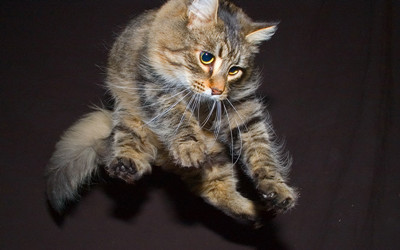Robots have evolved in leaps and bounds in recent years, but they still cannot safely leap or bound.
近几年机器人得到了跳跃式的发展,但在安全地进行跳跃活动方面却一直止步不前。
They have to move carefully.
它们只停留在小心谨慎移动的范畴。
If a robot were to fall from an elevated surface, for the most part it would crash down like a bag of rocks.
如果机器人从一个较高的地方跌落,大多数情况下会像袋石头一样。
Not ideal if that robot is on a rescue mission.
而如果该机器人在执行救援任务,后果会不堪设想。

So a team of Georgia Tech researchers wants to produce robots that are more agile, by making them literally cat-like.
因此乔治亚理工学院的一组科研人员希望能制造出更为灵活的机器人,或者说把它们做得像猫一样。
Specifically, the plan is to create a robot that can emulate a cat's uncanny ability to calculate the best landing angle, adjust its body midflight and land on its feet.
具体说来,这些研究人员的计划是设计出模拟像猫一样估计最佳着陆点、调整身体用脚着陆的具有“神秘能力”的机器人。
So far the research team has been able to build a robot capable of computing landing angles during test falls.
目前这个小组已成功造出一个能够在跳跃测试中计算着陆角度的机器人。
They hope to eventually give the robots joints that can twist or flip their bodies to stick the landing, regardless of the angle.
他们希望最终给机器人安装能够进行弯曲、翻转的关节,让它们可以不用考虑角度问题安稳着陆。
To do that, they'll need better motors and servos.
为了实现这个目标,他们需要更好的马达和伺服系统。
The ones available today are not fast enough to sufficiently adjust a robot's body in real time.
而现有的马达和伺服系统运算并不快,不能实时调整机器人的身体。
Baby steps. David Belle didn't develop the cityscape acrobatic activity known as Parkour overnight.
目前这只是起步阶段。大卫贝勒也没有在一夜间搞出诸如跑酷般的城市杂耍活动。
And the typical house cat has had tens of thousands of years to perfect the soft landing.
而传统的家庭养猫咪的完美软着陆则有几千年的历史。



